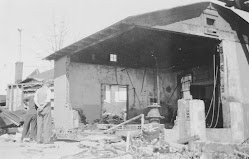The Hurricane of 1938
The unnamed hurricane of 1938 is purported to be the first major hurricane to strike New England since 1869. It was one of the most powerful and destructive hurricanes of the twentieth century.
Moving at 47 miles-per-hour, its center made landfall at the
time of an astronomical high tide and fueled storm tides of fourteen to
eighteen feet across the Connecticut coast. In addition, in 1938 there were no
advanced meteorological technologies such as radar, radio buoys, or satellite imaging
to warn residents of an oncoming hurricane.
 |
| Paul Palmer after he joined the U.S. Navy in 1942. Photo lent by the Palmer family to the Oral History Project. |
On September 21, 1938, Paul and
his classmates were dismissed from school at noon as heavy rain had been continuously
falling for several days. “I remember coming home and how hard that wind was blowing.
I can see the trees going over, you know, but there was no mention of a
hurricane.” Once home, Paul and his friend, John [Buster] Clarke, helped Paul’s
dad pump out the flooded cellar. Paul recounted, “Then I remember it started
raining again that afternoon. The tide was due to come in at night. It was an
afternoon tide. I’d say around five o’clock…That wind was blowing; man alive,
that wind was blowing. And then, all of a sudden, the rain had let up. I guess
the eye had come through, you see, and we thought everything was all over…And that’s
when we all took off.”
Paul and Buster heard police and
fire engine sirens coming down the street; they ran out to follow them and saw
a boat aground on Great Island. “And so, Buster and I said, ‘Well, gee, we can
get closer than this. Let’s walk the wall around’… and we crossed over to
Quigley’s Island [then part of the Martin J. Quigley property]. We went out on
the end out there, and we were watching them try to get the boat off and get
the people off the boat.” By this time, the rain and howling wind resumed as
the back end of the hurricane was coming around. The boys decided they had
better return home.
They crossed back over the bridge
connecting the Quigley property to the mainland and realized the water was to
the top of the wall. One of their neighbors, Mr. Pitcher, called to them
saying, “Boys, you better come in here for a minute. This tide is coming in
awful fast.” Paul agreed to go into the house, but Buster decided to run home. “He
ran around the corner of the house, and the water came up over the wall, and I
heard him holler and his feet went out from underneath him, and he went down
the wall with the wave… He went down alongside the house, and he grabbed ahold
of that telephone pole stay out there when he went by it, on the side of the
driveway.”
 |
| Flood waters on Arch Street during the September 1938 hurricane. Courtesy of the Greenwich Library Local History Collection. |
Paul’s training as a Boy Scout helped
prepare him for this emergency situation as he waded into the garage. “I found
a barrel and some line. So, I tied the line to the barrel. And I went over to the
side of the house, and I threw it out in the current, and let it float down to
the telephone pole. Buster grabbed a hold of it, and I said, ‘All right now,
I’ll tie it to the car, and you pull yourself in the lee of the house.’”
Unfortunately, at that point, the car started to float out of the garage.
 |
| Destruction caused by the hurricane in the Island Beach area. Courtesy of the Greenwich Historical Society. |
Like any parent, Mrs. Palmer was
beside herself with worry. “…and man alive, did we get it! My mother was having
a fit. She didn’t know where we were, where we had gone.”
The hurricane of 1938 and Mr.
Pitcher’s 1921 Sears and Roebuck house on Willowmere Circle in Riverside played
a significant role in Paul Palmer’s life. Paul had always admired the home, and
after Paul returned from naval service in World War II, Mr. Pitcher “put in his
will that if he died before he could sell me the house, that I would get it
through his estate at the assessed valuation. It was to be sold to me. I pretty
near flipped.”
Eventually, Paul purchased the
home and proudly described the many improvements he had made to it, most
notably, putting the furnace and the washer and dryer on the second floor. In addition,
“I rewired everything overhead. You see where the base plugs are? [waist-high]
Well, I know how deep it can get!”
The book “The 1938 Hurricane in Willowmere” may be read at
Greenwich Library and is available for purchase at the Oral History Project
office. The OHP is sponsored by the Friends of the Greenwich Library. Visit the
website at glohistory.org. Mary A. Jacobson, OHP blog editor.
By Mary Jacobson, OHP Blog Editor
No comments:
Post a Comment